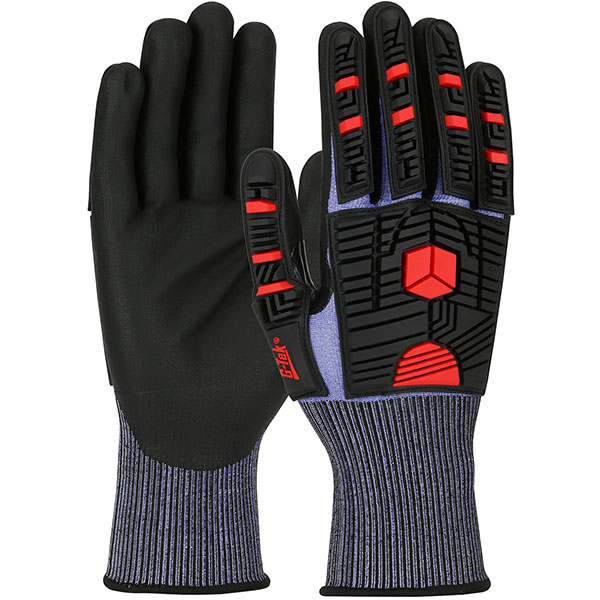Testing Methods and Scores
Currently, on many cut resistant gloves sold in North America, you will find the EN 388 marking. The EN 388, similar to ANSI/ISEA 105, evaluate the mechanical risks for hand protection. Gloves with an EN 388 rating are third party tested for abrasion, cut, tear, puncture and impact resistance. Cut resistance is rated 1-5 while all other physical performance factors are rated 1-4. Up until 2016, the EN 388 standard used only the “Coup Test” to test for cut resistance. The current standard uses both the “Coup Test” and the “TDM-100 Test” to measure cut resistance for a more accurate score. Also included in the standard is an Impact Protection test.

Two Effective Testing Methods of Work Gloves for Optimal Cut Protection
As discussed above, the most distinct component to the EN 388 2016 standard is the formal inclusion of the ISO 13997 cut test method. ISO 13997, also known as the “TDM-100 Test”, is similar to the ASTM F2992-15 test method used in the ANSI 105 standard. Both standards make use of the TDM machine with the sliding blade and weights. After many years of using differing testing methods for hand protection, it was discovered that the blade in the “Coup Test” would dull quickly when testing yarns with high levels of glass and steel fibers. This led to unreliable cut scores, highlighting the need for the inclusion of the “TDM-100 Test” to incorporate the EN 388 standard to ensure more accurate hand protection assessments.
EN 388:2016 Certification for Easy Identification
All PIP hand protection products are third party tested to EN 388 2016 with the shield clearly printed on the back of each glove for easy identification.

Frequently Asked Questions
Are EN 388 and ANSI 105 ratings directly comparable?
No, not directly. EN 388 and ANS 105 are not equivalent and cannot be compared as such due to the various testing methods used within each standard. To gain a better understanding of each test, reference our EN 388 vs ANSI/ISEA 105 Comparison Guide.
How do I interpret the test results for gloves under EN 388 and ANSI 105?
Look for the specific ratings (i.e.., 4 for abrasion resistance in EN 388 or A3 for cut resistance in ANSI 105) and consider how they align with the tasks and hazards your workers face. Higher ratings generally indicate better protection.
Which standard should I follow for selecting gloves?
This depends on your region and specific requirements. While most gloves sold in the US will have both markings, EN 388 is widely used in Europe and many other parts of the world, while ANSI 105 is commonly used in North America. Understanding local regulations and job-specific risks can help determine which standard to prioritize.
More questions?
Contact us and a PIP® hand protection expert will gladly assist in giving you a better understanding of how these standards can help employers and workers make informed decisions when selecting gloves to ensure adequate hand protection in various occupational settings.

 Hi Performance GloveG-Tek®120-5150
Hi Performance GloveG-Tek®120-5150
 Hi Performance GloveG-Tek® PolyKor®16-MPT630
Hi Performance GloveG-Tek® PolyKor®16-MPT630
 Extended Use Disposable GlovesGrippaz™ Skins67-246
Extended Use Disposable GlovesGrippaz™ Skins67-246
 Cut Resistant GlovesG-Tek® PolyKor®16-560
Cut Resistant GlovesG-Tek® PolyKor®16-560
 Evaporative CoolingEZ-Cool® Max396-EZ900
Evaporative CoolingEZ-Cool® Max396-EZ900
 Cut Resistant GlovesG-Tek® Paradox™16-541
Cut Resistant GlovesG-Tek® Paradox™16-541
 Hi Performance GloveG-Tek® PolyKor® X7™16-MP585
Hi Performance GloveG-Tek® PolyKor® X7™16-MP585
 Heated ApparelBoss®300-HV100
Heated ApparelBoss®300-HV100
 Protection From ColdG-Tek® PolyKor®41-1415
Protection From ColdG-Tek® PolyKor®41-1415
 Protection From ColdG-Tek® PolyKor®41-1417
Protection From ColdG-Tek® PolyKor®41-1417
 General Purpose Gloves - CoatedG-Tek®34-315
General Purpose Gloves - CoatedG-Tek®34-315
 Cut Resistant GlovesG-Tek® Paradox™16-351
Cut Resistant GlovesG-Tek® Paradox™16-351




































